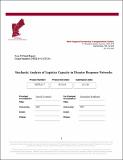Stochastic Analysis of Logistics Capacity in Disaster Response Networks
Author(s)
Goentzel, Jarrod; Rothkopf, Alexander
DownloadFull report (1.082Mb)
Metadata
Show full item recordAbstract
Quickly deploying relief items is key to reducing a population’s burden in case of sudden onset disasters. Emergency response organizations, such as FEMA or local and state agencies hold a strategic stockpile of critical relief items and contract for contingency stock in preparation for emergencies. Their response capacity depends on their decision to stock items at different depots, contracts with contingency suppliers, and procurement of transportation capacity to move these items.
Building on prior work of Acimovic & Goentzel (2016) we develop a stochastic linear programming model to capture carrier capacity and contingency suppliers. Inputs to the model are a risk portfolio reflecting the particular disasters and the inherent uncertainty with respect to when an organization needs to address a large or a small disaster. Further inputs are the organic stockpile of critical relief items, referred to as the inventory portfolio, contracts with contingency suppliers, which we term the supplier portfolio, and the portfolio of carriers at any depot location.
The model allows to conduct a system assessment and a system optimization. System assessment evaluates the current state and answers how well the current inventory, supplier, and carrier portfolio is able to meet a given risk portfolio. We present aggregate metrics to assess a system in three dimensions. We evaluate service metrics to answer how well the network meets demand of the affected population and how rapidly we reach the affected population, and efficiency metrics to indicate how much resources are necessary to meet demand. Taken together these metrics allow to evaluate the state of an emergency response network.
System optimization identifies the optimal allocation of inventory for a given supplier and carrier portfolio against a given risk portfolio. The models provides the above mentioned metrics for a decision-maker to compare to optimal network to the current on. In addition, we prescribe an inventory balance, a carrier contract, and a carrier utilization metric to capture the value of improvement.
In both – system assessment and system optimization – we evaluate a time-based model and a cost-based model to capture the inherent cost-time trade-off. Typically, more responsive suppliers and carriers are more expensive and less responsive suppliers and carriers are less expensive. When choosing where to allocate inventory, and which suppliers and carriers to contract an organization has to resolve this trade-off between cost and time. Our model provides insight into this trade-off and the impact on different performance metrics.
We use data from the openFEMA API to construct a new risk portfolio and estimate an inventory and a carrier portfolio to show the feasibility and functionality of our approach.
Date issued
2018-11Keywords
logistics, disaster response, humanitarian logistics